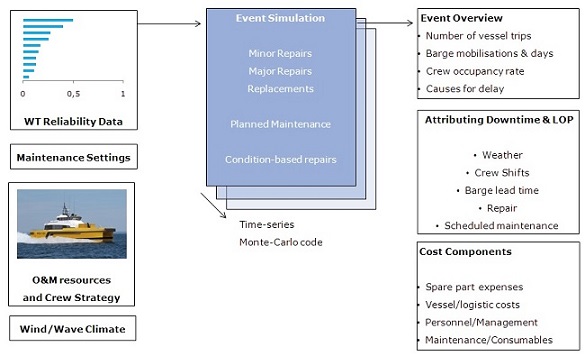
◀ Back to projects overview P201102-008-ENE
Benchmark of innovative O&M propositions for far and large offshore wind farms
Project background
Operation and Maintenance of offshore wind farms is expected to evolve in the coming decade. Wind farms are getting bigger and being built further offshore. At the same time, a growing range of innovative O&M propositions are entering the market (e.g. advanced transfer systems, faster vessels or more reliable wind turbine drive trains). This represents both a challenge and an opportunity to improve the efficiency of maintenance, and lower the cost of maintenance and thus the cost of offshore wind energy.
An important barrier to implementing such innovative propositions in any specific project is that technical solutions need to be identified as a realistic option at an early stage in the wind farm development process. The solution needs to be accounted for in the wind farm design and reflected in a reliable way in CAPEX & OPEX estimates, business cases and in the contracting strategy to eventually be implemented. In practice, innovative O&M propositions are often considered too late in the wind farm development process. Business‐As‐Usual solutions are favoured because of time pressure and because the costs, benefits and risks are better understood. Consequently, possible reductions in OPEX may not be achieved.The present study aims to address this issue by providing wind farm developers and turbine manufacturers with a quantitative assessment of the added value of a range of O&M propositions on a range of benchmark wind farms. The benchmark would enable to guide decisions on the maintenance strategies to be considered early during the development phase. The project partners, Eneco and XEMC Darwind, have identified a number of questions crucial to the early identification of any innovative O&M proposition for far larger offshore wind farms:
1. How are further and larger offshore wind farms expected to affect the wind farm O&M activities and performance?
2. What are the costs and benefits of the solution for far and large offshore wind farms? And what is the impact of the solution on the key parameters in O&M service contracts and the business case?
3. What is the sensitivity of these key parameters to weather and technical parameters and what year‐to‐year variability in OPEX and other O&M risks should be expected?
Overall, this study provides answers to a fourth underlying question:
4. Is cost reduction in OPEX achievable for Far Large Offshore wind farms?
The outcome of the study is a quantified comparative analysis of a number of innovative solutions on the base on three key indicators: the maintenance costs, the loss of production (LoP, expressed in EUR) and the combined costs being the sum of maintenance costs and LoP. Beside the average values of these costs, their respective variability and resulting cost risk was considered.
As part of the study, an industry review of a number of crew access technologies was performed. Their technical specification, operational performance and cost related information have been summarized and used as inputs in the O&M model.
Ecofys O&M Model
The Ecofys Offshore Wind O&M model is a time‐based model which reproduces the maintenance and logistics behaviour of an offshore wind farm over a period of time. The typical chain of events: failure, waiting time, travelling repair, restart of wind turbine is reproduced for a wind farm defined in the model. The model makes use of some parameters (e.g. number of wind turbines, component cost) and some inherently variable inputs (e.g. wind and wave climate, occurrence of a wind turbine failures) in order to calculate wind farm specific Key Performance Indicators (e.g. maintenance costs, time‐ and production‐ based availability) under relevant scenarios. The model uses a Monte‐Carlo simulation method to calculate variability of the output.

Figure 1 Outline of the Ecofys O&M model
Main conclusions of the project
OPEX is estimated to account for about 30% of overall project costs for operational offshore wind farms. Combined costs of O&M will increase with wind farms that are located further from shore. Optimizing O&M strategies is crucial to reduce these costs:
1. Increase of WF size could result in economies of scale on Combined costs estimated to approximately 10%
2. Improvement of wind turbine reliability could allow for reduction of Combined Costs by approximately 25%. Improvement in CMS and reparability could yield further savings in the range of 5%.
3. Offshore accommodation will be required for far offshore wind farms. Provided that the vessel size is adapted to the wind farm, cost reduction of 5 to 10% could be reached.
4. Improved crew vessel are not expected to play a major role in reducing OPEX, but could be beneficial from and HSE point of view.
5. Reduction of yearly variability of maintenance costs and Loss of production are expected to be achieved thanks to more reliable wind turbine technologies, better access strategies and larger wind farms. Reduction of risk margin could results in decrease of combined maintenance costs by an additional 5%.
It is too optimistic to assume all of the above mentioned cost reduction potentials are realized in the near future. A realistic value may be that 5 to 15% of OPEX & LoP cost reductions can be achieved in the near future by applying better vessels and making use of economies of scale.
The resulting LCoE reductions, for the example with 5% and 15% cost reduction in OPEX & LoP, were calculated using the FLOW cost model and account to 0.8 to 2.6%.
Partners involved
- Eneco
- XEMC-Darwind
Contact details
Mr. Glenn Bijvoets

 Share this page
Share this page
